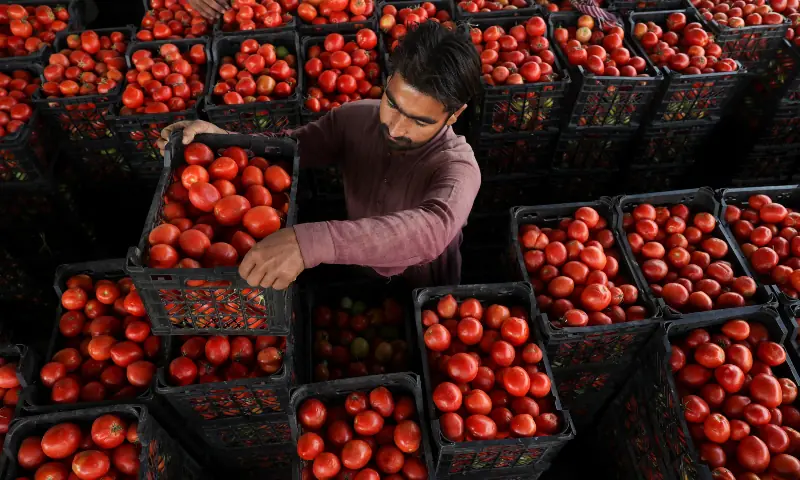
• Amid limited supplies from Swat and Sindh, rates coming down due to imports from Iran
• Supply may dip next year as flood impacts on Punjab’s cultivation manifest
KARACHI: After a sharp rise[1] in tomato prices, reaching Rs600–700 per kilogramme, rates are now declining due to steady imports from Iran — further influenced by limited local supplies from Swat and Sindh.
But if things remain the same, the country is likely to face a shortage of tomatoes in the spring season next year, potentially triggering another cycle of price hikes.
According to traders, floods[2] and heavy rains in Punjab have reportedly washed away the tomato crop. However, they ruled out any serious impact on the Sindh crop, as markets in Karachi have begun seeing arrivals of the new crop from the province, although the majority consists of unripe tomatoes.
Traders are seen offering Iranian tomatoes at Rs200 per kg in Karachi, providing some breathing space to the consumers, who paid up to Rs560[3] per kg last week in the city.
Local tomato crops in all provinces are produced throughout the year. However, there are often instances of supply imbalances in certain provinces when a crop season ends. At times, only one province produces enough tomatoes to supply the other three. In such cases, the only option to bridge the demand-supply gap is to import tomatoes from Iran and Afghanistan.
The closure[4] of the Pak-Afghan border for over two weeks, combined with years-long suspension of trade with India, has left Iran as the only viable option to meet domestic demand.
However, he added that the supply of tomatoes will decline from March to April next year.
‘Supply to dip’
Syed Khaliq Shah of the Ravi Sabzi Mandi Lahore said the supply of new tomatoes from some areas of Sindh was under way in the last few days, but consumers will see improved supplies during November to February.
He explained that crops in Punjab usually find their way to the market in the middle of the year but the recent rains and floods have destroyed tomatoes.
“The supply of new crops from Khyber Pakhtunkhwa will get start from May to August followed by new crops from Balochistan after March. However, negligible arrivals have started from some areas of Balochistan like Quetta.”
Mr Shah said rains had damaged the crop in Swat, causing a drop in the arrival of trucks to 20-30 daily in Punjab instead of 150-200 vehicles on normal days.
He added that Iran’s tomatoes (a pack of 8-9kgs) is available at Rs1,000-1,500 in Lahore against Rs2,500-4,000 a few days ago. While Swat’s tomatoes in a 15-16kg pack are priced at Rs2,500-4,000 compared to Rs 4,500-6,000.
Punjab is currently dependent on tomato shipments from Swat and Iran, with around 70–90 trucks from Iran arriving in the province daily. The journey from Iran takes five to six days, whereas tomatoes from Afghanistan arrive in just two days.
Waheed Ahmed, patron-in-chief of the Pakistan Fruits and Vegetables Dealers, Merchants, Exporters, and Importers Association, said the rains and floods have severely damaged the tomato crop in Punjab, as well as in parts of Balochistan and Sindh. Additionally, supplies from Afghanistan have been suspended due to the tense border situation between the two neighbouring countries.
In a crisis situation, he recalled that a significant quantity of tomatoes used to be imported from India, but these imports were discontinued after a disease emerged in 2016–2017. At the same time, excessive imports from neighbouring countries discouraged local farmers from cultivating more tomatoes.
Given the dollar shortage and low transportation costs, importing tomatoes from neighbouring countries such as India, Iran, and Afghanistan could help stabilise prices, rather than letting local rates collapse. There is also potential to source tomatoes from Commonwealth countries, depending on the border situation and the availability of a smooth supply chain, he added.
“The government can reduce or eliminate duties and taxes on tomato imports to prevent further crises,” he suggested, recalling that Pakistan had previously imported onions[5] from its neighbours to bridge supply gaps caused by limited local production.
Mohammad Rafiq Gujjar, chairman of the Masha Khor Welfare Association at Karachi’s Sabzi Mandi, said that September and October are always crucial months, as the local tomato crop is not yet ready and demand is met through imports. “Unfortunately, floods have caused significant damage in Punjab, while the Sindh crop appears relatively safe due to the low intensity of floodwaters reaching the region from Punjab,” he added.
Published in Dawn, October 27th, 2025
